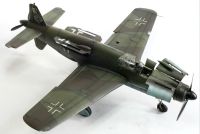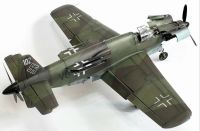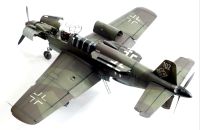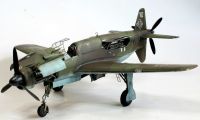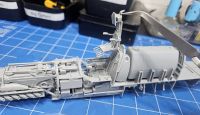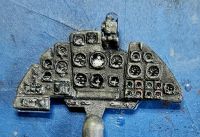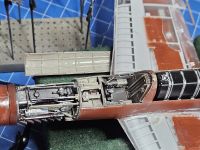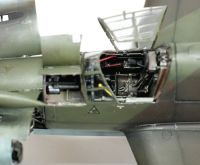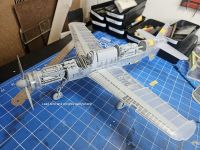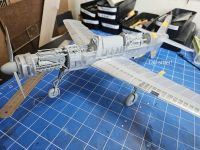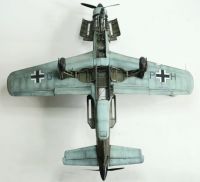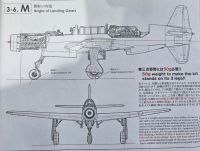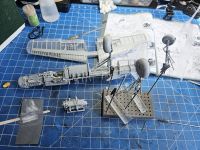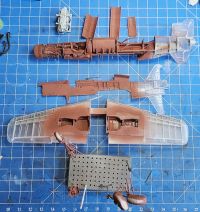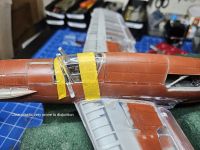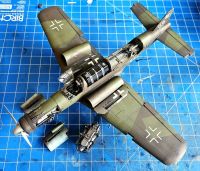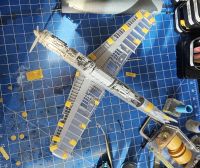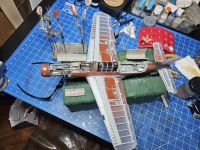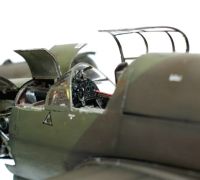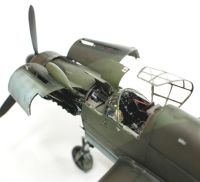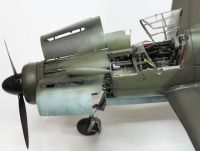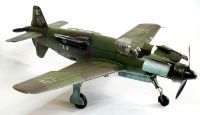Zoukei-Mura 1/32 Dornier Do 335
By Suresh Nathan
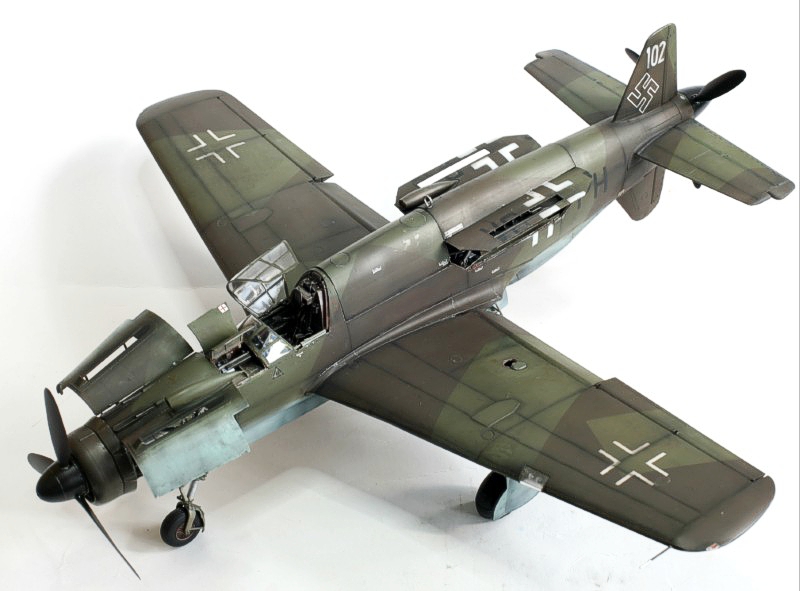
Introduction
During the final years of World War II, some of the fastest and most advanced aircraft ever built took to the skies. Among them were the Dornier Do 335, the P-51D Mustang, and the Messerschmitt Me 262. Each had its own strengths, but when it came to raw speed in level flight, the Me 262 was unmatched. Powered by jet engines, it could reach speeds of up to 900 km/h (559 mph). The Do 335 wasn’t far behind, with a top speed of 763 km/h (474 mph), while the famous American P-51D Mustang could hit about 700 km/h (440 mph). A Spitfire was pretty fast in a dive but we're referring to level flight here.
But speed was just one part of the story. The Do 335 had a special twin-engine setup—one engine in front and one in the back—which gave it a strong climb rate and a longer flight range than the Mustang. This meant it could reach high altitudes quickly and stay in the air longer. On the other hand, the Me 262 had the most powerful weapons of the three. It was armed with four 30mm cannons, making it especially deadly against enemy bombers.
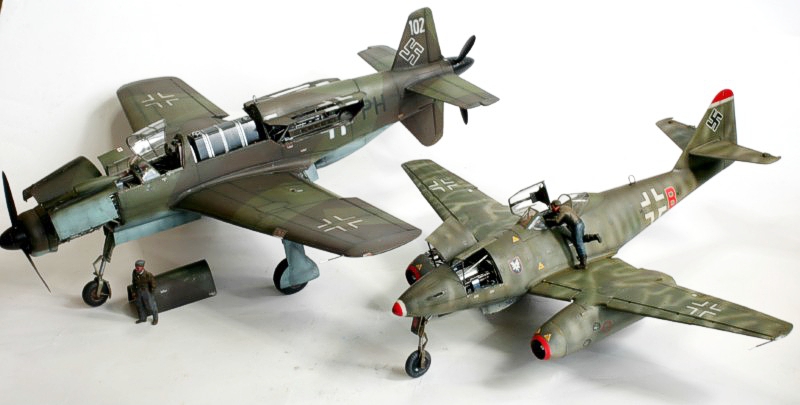
Even with its impressive design, the Do 335 faced major setbacks. It was developed very late in the war, at a time when Germany was struggling to keep its war machine running. Although production was planned, it was slowed down by shortages of parts, especially engines. Because of this, the Do 335 never made it into full combat service.
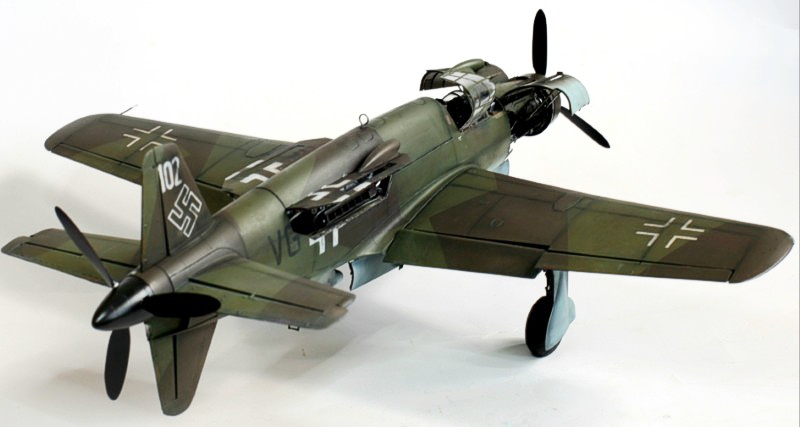
Only a few early models were built, and these were mostly used for testing and training. None were officially flown in battle before the war ended. However, there’s one story that adds a bit of mystery to the aircraft’s history. French fighter ace Pierre Clostermann claimed he came across a Do 335 while flying his Hawker Tempest in April 1945. According to him, the German plane easily outran his Tempest—even though the Tempest could reach speeds of over 700 km/h at low altitude. The encounter was never recorded in official reports, but it remains an intriguing possibility.
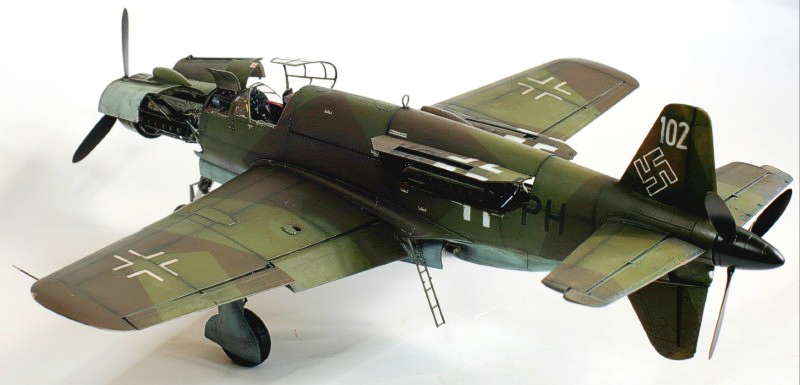
In the end, the Dornier Do 335 was a powerful and innovative aircraft that came too late to change the course of the war. Its speed, range, and climb performance were impressive, but history never gave it the chance to prove itself in combat.
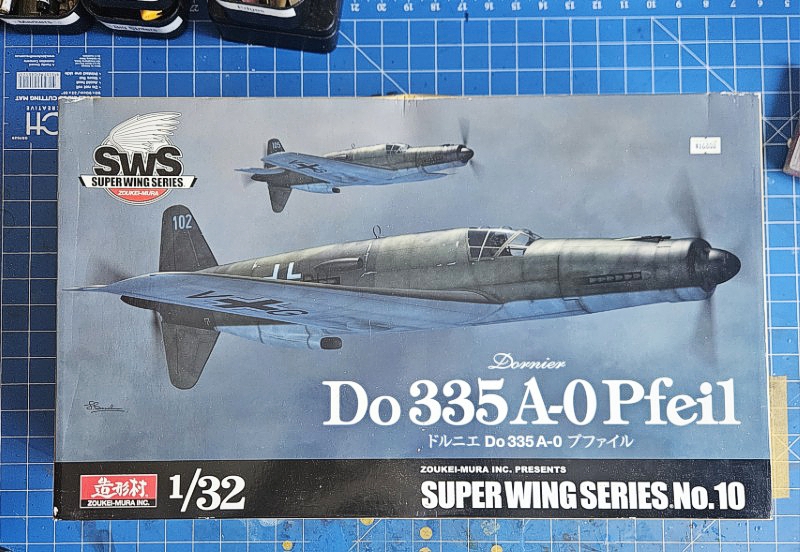
Model
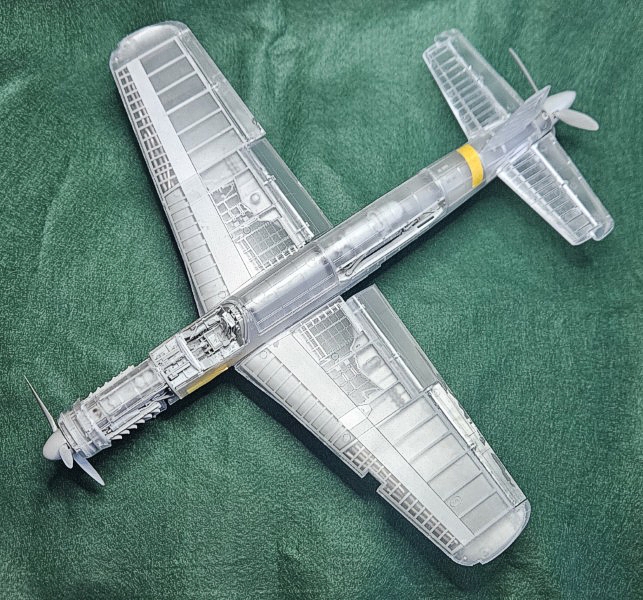
Zoukei-Mura produced the Do335 A-0 and an A-12 between 2016 and 2018. It’s actually newer than the HKM model of 2014. Contrary to popular belief it is not the Destroyer variant (which is HKM). The model is finely produced and is considered the de facto standard for Do335 in this scale. The accuracy is very good and stands to be enhanced with minor modifications mainly to do with wiring. It comes with clear parts which like many modelers I do not like. These clear parts are a major problem in construction. They are brittle and do not conform well to their counterpart. They crack easily. They are resistant to sanding and don’t scribe well. They don’t take standard styrene glue well and cyano causes it to crack at the glue edge. Further almost nobody ever makes them to display the innards. I hope that ZM just stops doing this as it ruins an otherwise awesome kit which costs a pretty penny. I bought mine some years ago in Japan and have always looked forward to building it one day. It is completely detailed down to cavities you’ll never see, like the pistons in the engine and the details in the sealed rear of the plane. The fuselage and wing parts are frosted so you actually can’t see through them very well anyway. The ground light cover is similarly frosted which is inaccurate. I researched the wing tip lights and found that the real thing had coloured bulbs within and a clear glass cover and not a coloured cover like you see in the Udvar Hazy museum.
Cockpit and wheel wells
The cockpit is out of box with a few wires for the dashboard rear. These are barely visible in the completed kit but still worth modeling. The cockpit tub has narrow spaces on either side that should be used for weights. I elected for the rear decal in a see-through dashboard. Three options are provided namely this see-through, an opaque one and a third with individual dial decals. Vinyl masks are provided for the canopy and work very well.
Undercarriage
With the addition of nose weights the model is significantly heavier and Zoukei-Mura has provided brass struts identical to the plastic option as an aftermarket option. My model uses the plastic undercarriage and currently the weight of the model is causing severe deformation with the undercarriage now resting on the top part of the tyre. This will hold for now but might need to be replaced in future. The plastic tyres are molded separately and lend themselves nicely to be weighted which I did with a heat gun for a gentle bulge.
Engine Compartment
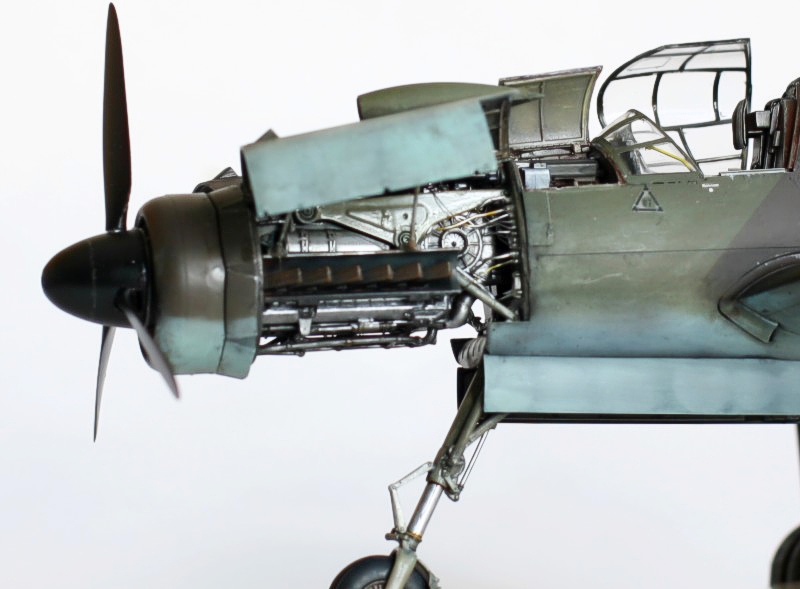
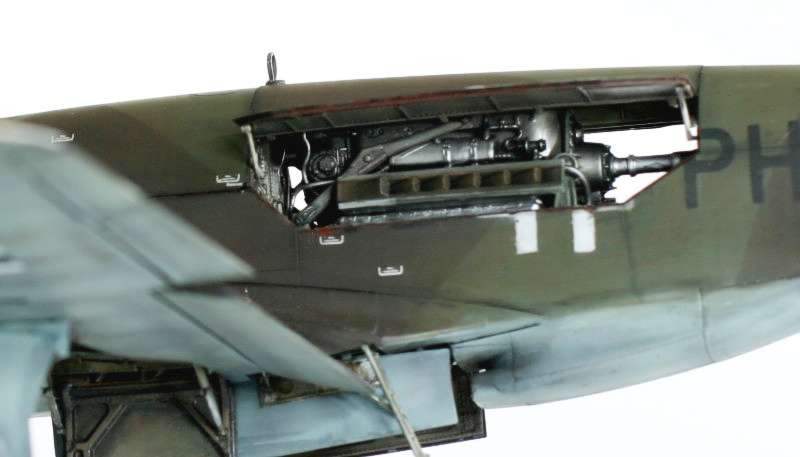
The front and rear DB603L engines are beautifully moulded. Both can be detachable with some effort and repairable damage but I chose to glue in the front engine and kept the rear removable in case I do a maintenance diorama in future (unlikely). In the model the wire attachment points are represented by slightly raised knobs. These should be drilled out and the wires inserted into the footprint. It’s not really durable to glue wires onto the knobs. I wired it according to references up to the coupling with the firewall. The engines are molded with piston details which are completely not displayable. The also limit the amount of weight you can put in the engine.
Ordnance
Ordnance is not provided even as the futuristic concealed bomb bay is fully detailed. ZM does not make a Destroyer version of the model but wing guns are easily fabricated if desired. I like the purity of the Do335 profile and stuck with the original.
Fuselage and wings
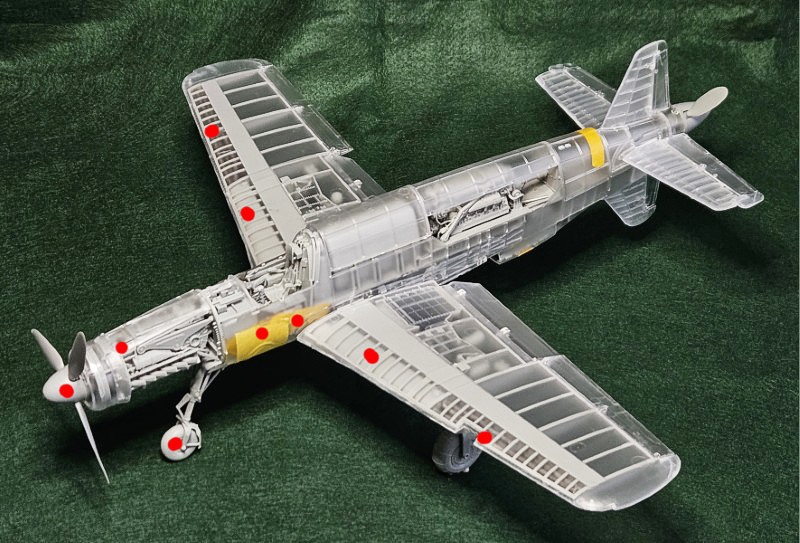
The fit on the parts is very good. Nevertheless the choice of clear plastic is poor. It is a brittle material that does not take styrene glue well. Cyanoacrylate will bond it but the surrounding margins of the glue will crack. The illustration shows the red dots where the model needs to be weighted to keep it a nose sitter. The instructions recommend 50g of weight in the nose but in my case it took closer to 250g. This is a lot for the plastic undercarriage and it is beginning to deform. ZM does provide an aftermarket brass undercarriage for this but in hindsight its probably more practical and easier to create a strut or dolly under the rear rudder to keep it up.
Painting and markings
The model was base-painted in Humbrol RLM air enamels, varnished with Future-Tamiya Flat acrylic, weathered with turpenoids and chipped sparingly. I used oil washes for weathering and drop filters for colour variation. Black was used as a panel wash. The worn silver was a combination of sponge dabbing, silver pencil and undercoat and masking of silver with overspray. The Do335’s were well maintained by highly skilled crew and chipping was barely noticed. The markings match the Dornier Do 335 240 102 on display at the Steven F. Udvar-Hazy Center in Chantilly, Virginia. This was provided in the kit and is fairly comprehensive. Nevertheless, the paint scheme on the box, instructions and website are somewhat inaccurate and I used references from the internet to paint . I looked up the actual plane and it appears the light blue (Mattb 65) undersurfaces is preferred over the usual Licht Blau. Light green (RLM82) and brown purple (RLM81) was traced out in the usual manner. This is the approach I undertook and I must say it appears a lot more authentic. The RLM Air line of Humbrol colours is spot on. The RLM 02 in the wheel and engine wells is colour modulated with red base and results in a more vibrant finish. All larger markings were traced from the decal sheet onto vinyl adhesive sheet and painted. Technical markings were decals.
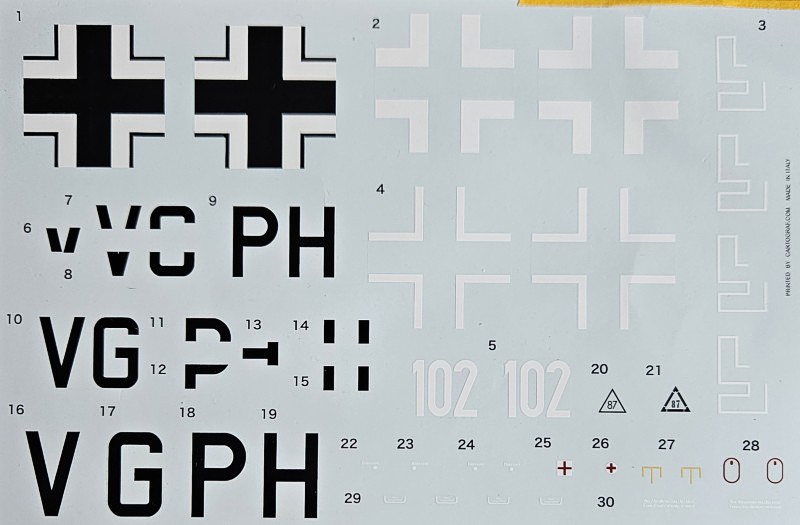
Conclusion
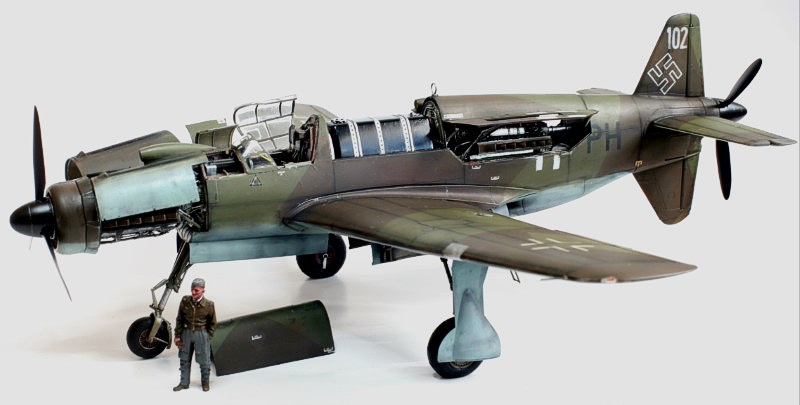
Apart from the minor misgivings of the clear plastic opted for in Zoukei Mura models you can’t fault the engineering. They give you an incredible kit with all the bells and whistles included. They just need careful attention to model making and a good paintjob. This model is exceptional and I would strongly recommend it. Increasingly, I find that painting from actual photos is a better undertaking than following the kit instructions. Nevertheless, in ZM kits this is a very productive practice. As a bonus the weathering is kept in check to realistic levels.
© Suresh Nathan 2025
This article was published on Friday, May 02 2025; Last modified on Monday, May 05 2025

